Joules for cardioversion - Study guides, Class notes & Summaries
Looking for the best study guides, study notes and summaries about Joules for cardioversion? On this page you'll find 409 study documents about Joules for cardioversion.
All 409 results
Sort by
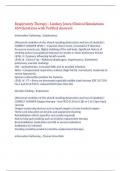 Popular
Popular
-
Respiratory Therapy - Lindsey Jones/Clinical Simulations 459 Questions with Verified Answers,100% CORRECT
- Exam (elaborations) • 127 pages • 2023
-
- $13.49
- 1x sold
- + learn more
Respiratory Therapy - Lindsey Jones/Clinical Simulations 459 Questions with Verified Answers Information Gathering - Emphysema: (Abnormal condition of the alveoli resulting destruction and loss of elasticity) - CORRECT ANSWER LEVEL I : Cyanosis, Barrel chest, increased A-P diameter, Accessory muscle use, Digital clubbing of the nail beds, Significant history of smoking and/or occupational exposure to smoke or other pulmonary irritant LEVEL II : Dyspnea, Wheezing breath sounds LEVEL III ...
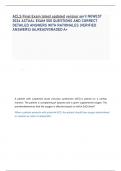 Popular
Popular
-
ACLS Final Exam latest updated version april NEWEST 2024 ACTUAL EXAM 500 QUESTIONS AND CORRECT DETAILED ANSWERS WITH RATIONALES (VERIFIED ANSWERS) |ALREADY GRADED A+
- Exam (elaborations) • 26 pages • 2024 Popular
-
- $12.49
- 1x sold
- + learn more
ACLS Final Exam latest updated version april NEWEST 2024 ACTUAL EXAM 500 QUESTIONS AND CORRECT DETAILED ANSWERS WITH RATIONALES (VERIFIED ANSWERS) |ALREADY GRADED A+ A patient experiences cardiac arrest, and the resuscitation team initiates ventilations using a bag- valve-mask (BVM) resuscitator. The development of which condition during the provision of care would lead the team to suspect that improper BVM technique is being used? Complications can occur with the use of a BVM resuscitator due...
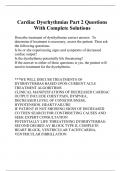
-
Cardiac Dysrhythmias Part 2 Questions With Complete Solutions
- Exam (elaborations) • 24 pages • 2023
-
Available in package deal
-
- $10.99
- 1x sold
- + learn more
Describe treatment of dysrhythmias correct answer: To determine if treatment is necessary, assess the patient. Then ask the following questions: Is he or she experiencing signs and symptoms of decreased cardiac output? Is the dysrhythmia potentially life threatening? If the answer to either of these questions is yes, the patient will need to treatment for the dysrhythmia. ***WE WILL DISCUSS TREATMENTS OF DYSRHYTHMIAS BASED UPON CURRENT ACLS TREATMENT ALGORITHMS CLINICAL MANIFESTATIONS ...
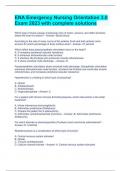
-
ENA Emergency Nursing Orientation 3.0 Exam 2023 with complete solutions
- Exam (elaborations) • 51 pages • 2023
-
Available in package deal
-
- $14.99
- 1x sold
- + learn more
Which type of shock causes a temporary loss of motor, sensory, and reflex functions below the level of a lesion? - Answer- Spinal shock According to the rule of nines, burns of the anterior trunk and both anterior arms account for which percentage of body surface area? - Answer- 27 percent Which effect does parasympathetic stimulation have on the heart? A. It increases peripheral vascular resistance. B. It enhances atrioventricular node function. C. It shortens His-Purkinje and ventric...

-
PALS version B Questions and Answers 2023
- Exam (elaborations) • 6 pages • 2023
-
Available in package deal
-
- $23.49
- 1x sold
- + learn more
PALS version B Questions and Answers 2023 You are treating an 8-year-old with ventricular tachycardia (VT) with pulses and adequate perfusion. You attempted synchronized cardioversion without success. While seeking expert consultation, it would be most appropriate to: Administer a loading dose of milrinone Initiate overdrive pacing transcutaneously Consider possible metabolic and toxicologic causes Deliver an unsynchronized shock Consider possible metabolic and toxicologic causes ...
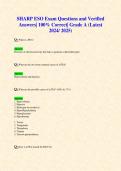
-
SHARP ESO Exam Questions and Verified Answers| 100% Correct| Grade A (Latest 2024/ 2025)
- Exam (elaborations) • 17 pages • 2024
-
Available in package deal
-
- $10.99
- + learn more
SHARP ESO Exam Questions and Verified Answers| 100% Correct| Grade A (Latest 2024/ 2025) Q: What is a PEA? Answer: Presence of electrical activity that fails to generate a detectable pulse Q: What are the two most common causes of a PEA? Answer: Hypovolemia and hypoxia Q: What are the possible causes of a PEA? (6 H's & 5 T's) Answer: 1. Hypovolemia 2. Hypoxia 3. Hydrogen ion (acidosis) 4. Hypo/Hyperkalemia 5. Hypoglycemia 6. Hypothermia 1. Toxins 2. ...
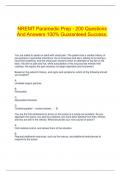
-
NREMT Paramedic Prep - 200 Questions And Answers 100% Guaranteed Success.
- Exam (elaborations) • 72 pages • 2024
-
- $11.49
- + learn more
NREMT Paramedic Prep - 200 Questions And Answers 100% Guaranteed Success. You are called to assist an adult with chest pain. The patient has a cardiac history of two-posterior myocardial infarctions. He is conscious and alert, stating he is having a hard time breathing, and the chest pain worsens when he attempts to lay flat on his back. His skin is pale and hot, while auscultation of his lung sounds reveals mild crackles. He reports the pain worsens on deep inspiration and movement...
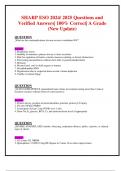
-
SHARP ESO 2024/ 2025 Questions and Verified Answers| 100% Correct| A Grade (New Update)
- Exam (elaborations) • 13 pages • 2024
-
Available in package deal
-
- $10.49
- + learn more
SHARP ESO 2024/ 2025 Questions and Verified Answers| 100% Correct| A Grade QUESTION (New Update) What are the contraindications for non invasive ventilation NIV? Answer: 1. Respiratory arrest 2. Inability to maintain a pateny airway or clear secretions 3. Risk for aspiration of hastric contents (nausea,vomiting, or bowel obstruction) 4. Preexisting pneumothorax without chest tube or pneumomediastinum 5. Epistaxis 6. Recent facial, oral or skull surgery or trauma 7. Encepha...
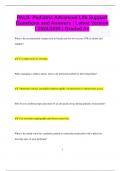
-
PALS- Pediatric Advanced Life Support Questions and Answers | Latest Version | 2024/2025 | Graded A+
- Exam (elaborations) • 26 pages • 2024
-
Available in package deal
-
- $9.88
- + learn more
PALS- Pediatric Advanced Life Support Questions and Answers | Latest Version | 2024/2025 | Graded A+ What is the recommended compression-to-breath ratio for two-rescuer CPR in infants and children? 15 compressions to 2 breaths. When managing a child in shock, what is the preferred method for delivering fluids? Administer isotonic crystalloid solution rapidly via intravenous or intraosseous access. How do you confirm proper placement of an advanced airway during pediatric re...
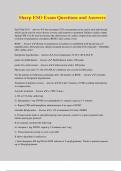
-
Sharp ESO Exam Questions and Answers 2024 Graded A
- Exam (elaborations) • 19 pages • 2024
- Available in package deal
-
- $13.49
- + learn more
Sharp ESO Exam Questions and Answers End Tidal CO2 - Answer ️️ -the maximum CO2 concentration at the end of each tidal breath, which can be used to assess disease severity and response to treatment. Reflects cardiac output during CPR. Can be used to measure the effectiveness of cardiac compressions and assessment of return of spontaneous circulation (ROSC) after cardiac event ROSC - Answer ️️ -Return of spontaneous circulation is established with the presence of palpable pulse, blo...
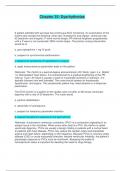
-
Chapter 35: Dysrhythmias | Questions, Answers and Rationales
- Exam (elaborations) • 73 pages • 2024
-
- $28.49
- + learn more
Chapter 35: Dysrhythmias | Questions, Answers and Rationales A patient admitted with syncope has continuous ECG monitoring. An examination of the rhythm strip reveals the following: atrial rate 74 beats/min and regular; ventricular rate 62 beats/min and irregular; P wave normal shape; PR interval lengthens progressively until a P wave is not conducted; QRS normal shape. The priority nursing intervention would be to a. give epinephrine 1 mg IV push. b. prepare for synchronized cardioversion. c...

$6.50 for your textbook summary multiplied by 100 fellow students... Do the math: that's a lot of money! Don't be a thief of your own wallet and start uploading yours now. Discover all about earning on Stuvia


